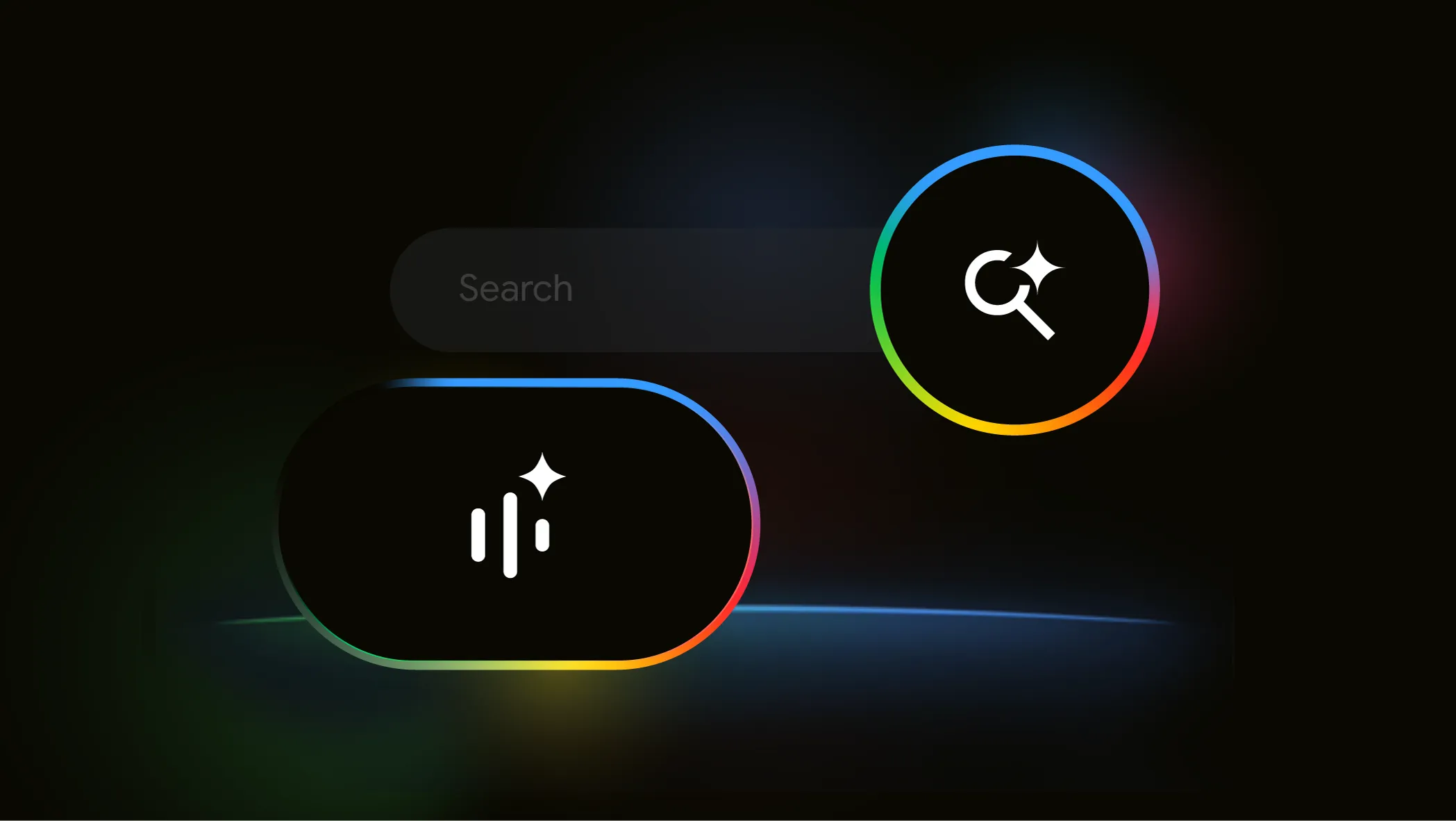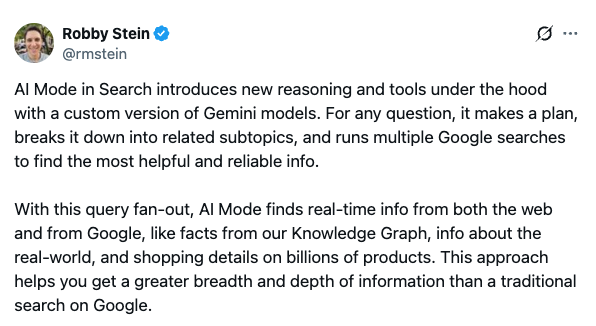
Google’s newest AI Mode feature, Search Live, has launched for U.S. users in the Google app, and it marks a significant turning point in how users interact with search.
Instead of typing queries, users can now engage in natural, voice-led conversations with real-time AI responses and access web content via links shown on their device’s screen.
Now, let’s address the elephant in the room: we all remember the hysteria around voice search when it first entered the SEO scene…and we all remember how little that innovation amounted to about how people use search engines.
But, given how AI advances have pushed digital marketers into an entirely new professional paradigm in the last 12-or-so months, it seems wrong to discount the potential impacts of this latest feature release.
Below, we break down the potential SEO implications and how your content strategy needs to evolve to keep pace with the state of search in 2025.
What Is Search Live?
Search Live is a new Google feature that allows users to:
- Hold natural, spoken conversations with Google Search
- Get AI-generated audio responses in real time (powered by Gemini)
- See web links on-screen while receiving voice answers
- Ask follow-up questions with full memory of the conversation context
- View transcripts and toggle between voice and text input
- Continue the conversation while using other apps on their phone
- Access past conversations in the AI Mode history tab
In its post-launch press release, Google hinted at upcoming Live capabilities, including camera-based integration, allowing users to show Google what they’re seeing and ask questions about it in real time.
The feature is currently US-only and available through Google Labs for users who opt into AI Mode. But if we follow the tradition of recent changes, it’s only a matter of time before these new AI features are rolled out globally, so now is your chance to get ahead of the game.
I’m an SEO…why should I pay attention to Search Live?
Google is moving fast. We all know that. It’s locked in a technology-driven cold war with OpenAI, and the winner will be the one that secures and maintains the biggest market share in a new era of LLM-based information retrieval.
This tells us one thing: Search Live isn’t just another Silicon Valley Lab experiment that will fizzle out in a few months. Its release builds upon the seismic shifts we’ve already seen across SEO, digital PR, content marketing, and other search-based channels, and it’s potentially something we need to be acting on now to safeguard performance down the line.
Here’s our take on what it means, and what you should be doing now to prepare.
1. Search Is Becoming A Conversation, Not A Query
Search Live builds on recent AI innovations to change the very format of search: users are no longer entering isolated queries but engaging in real, flowing conversations.
That shift means users expect continuity, context, and responsiveness, not just an answer to their initial question. For SEO, this requires a fundamental change in how we structure, phrase, and sequence content.
Why this matters…
Voice-led search is not only more natural, it’s more revealing.
Instead of a user typing “linen packing tips,” they might say, “I’m packing for a trip and want to stop my linen dress from wrinkling. What can I do?”
This kind of query carries intent, emotion, and scenario-specific context. And because Search Live holds onto previous questions, follow-up queries are now part of the same session, which may make isolated optimisation tactics ineffective.
How do you incorporate conversational search into SEO strategies?
- Write content as if you’re answering questions in a conversation → Use full-sentence subheadings and transition phrases to mimic human dialogue.
- Cluster by topic, not just keyword → Group related questions and answers into hubs that mirror how a user might explore a topic in stages.
- Use dialogue-based prompt testing → Simulate realistic conversations with tools like Perplexity or Gemini to see how your content supports a back-and-forth flow.

Final tip: If your page only answers a single query, it’s no longer enough. Think in conversations, not keywords, and gather data from beyond traditional research tools.
2. SERP Positions Still Matter, But The Rules For Earning Visibility Have Changed
One of the biggest surprises in Search Live is that Google still shows web links alongside its AI-generated voice responses. This means publishers still have an opportunity to appear in front of users, but how you get there and stand out has changed.
Why this matters…
In traditional search, visibility came from satisfying the core pillars of SEO: technical foundations, high-quality on-site content, and off-page authority via links. In short, it was a relevance and authority game.
In the era of tools like Search Live, visibility is far more layered. Google’s Gemini model selects responses based on summarisation quality, source diversity, and clarity. That means your content needs to perform well not only in organic rankings, but also in how easily it can be extracted, understood, and spoken aloud by an AI.
This is a different kind of optimisation.
How to incorporate this into SEO strategies
- Make content skimmable and scannable → Use short paragraphs, a clear HTML structure, consistent heading hierarchies, and concise language that AI can extract cleanly.
- Present information in ways that LLMs can understand → Write using language features like semantic triples to make sure AI models can understand how different ideas and entities relate to each other in a given context.
- Write with summaries in mind → Use intro blurbs and paragraph openers that explain the answer up front, then expand afterwards.
- Test how your page sounds aloud → Read paragraphs out loud to identify awkward phrasing or redundancies that may not work in voice results. Remember: if you wouldn’t say it, don’t write it!
- Optimise titles and meta descriptions → These still influence clickthroughs, especially when links are shown on a compact screen with limited real estate.
Final tip: Don’t just ask, “Can this rank?”. Ask yourself, “If this is read out loud, will it still be useful?”
3. Search Intent Is Now Layered, Not Linear
Users no longer search in isolated bursts (sorry, short-tail keywords).
With Search Live and other more conversational search formats, they explore topics through multi-step, context-aware questions that evolve in real time. SEO strategies must shift from capturing one-off intent to supporting an intent journey.
Traditional keyword research focuses on identifying intent based on single phrases, such as “best travel backpacks,” “how to iron shirts,” etc.
But Search Live isn’t built for users who want to stop at one quick question.
It’s built to facilitate fluid, stacked intent. Users might ask about packing tips, then segue into weather forecasts, outfit planning, or luggage recommendations.
Why this matters…
Traditional keyword research focuses on identifying intent based on single phrases, such as “best travel backpacks,” “how to iron shirts,” etc.
But Search Live isn’t built for users who want to stop at one quick question.
It’s built to facilitate fluid, stacked intent. Users might ask about packing tips, then segue into weather forecasts, outfit planning, or luggage recommendations.
For example:
“How do I keep linen from wrinkling?”
“What if it still wrinkles after I’ve tried this?”
“Is steaming or ironing better for travelling?”
“Recommend some travel garment steamers.”
Ultimately, if your content doesn’t support this movement across micro-intents and progressive exploration, the conversation will end in a dead end.
How to preserve conversation pathways
Here’s how to structure content that supports topical progression:
- Use intentional subheadings that mirror natural follow-up questions → For example, build a logical flow from “How to pack linen when travelling” to “What to do if linen wrinkles” to “Best on-the-go fixes for creased garments”.
- Avoid hard stops or isolated blocks → Don’t treat each section as self-contained; think in terms of the overarching narrative flow. (Caveat: AI search does support passage-based ranking, so ensure each section or block fully answers a query.)
- Use internal links to deepen exploration → Link to dedicated guides or related FAQs that mirror likely follow-up intent. For example, say, “To learn more about topic X, read our export guide on Y”.
- Write with semantic layering in mind → Use varied phrasing to capture alternative formulations (e.g. “get rid of creases” and “de-wrinkle clothes”).
Final tip: Modern searchers aren’t just asking what, they’re asking what’s next, and our answers need to proactively anticipate what this “what’s next” might be. To win, we need to build for the search journey, not just the entry point.
4. Query Fan-Out and the Rise of Diverse Perspectives
Search Live doesn’t just generate one “best” answer; it uses a method called query fan-out (thanks to Marie Haynes for her stellar write-up of this), where your question is distributed across multiple systems to gather a broader, more diverse set of ideas and informational nuggets.
This means Google is no longer just prioritising precision; it’s deliberately surfacing a range of viewpoints and voices. For SEOs, this is a new playing field.

Why this matters…
In classic search, authority and relevance often converged into a single dominant result—the “blue link at the top.” But query fan-out disrupts that.
Instead of trying to return one correct answer, Google now acts like a curator, offering a portfolio of perspectives all in one neat package. This opens up new opportunities for visibility, but only if your content adds something fresh or differentiated.
Generic, derivative, or purely SEO-driven content is more likely to be filtered out in favour of pieces with originality, expertise, or nuance (yes, this means you can’t build a strategy around putting prompts into ChatGPT and churning out bang-average content).
How to incorporate this into SEO strategies
- Offer layered perspectives within your content → Include expert quotes, opposing views, use cases, or comparative frameworks that present your topic from multiple angles.
- Inject authorial voice and credibility → Anonymous or generic content is more likely to be ignored. Use named authors, cite sources, and highlight qualifications or real-world experience.
- Use tools like Qforia and Perplexity.ai to find fan-out opportunities → Both platforms allow you to see how questions are answered across sources with natural language-based expansions, helping you spot gaps in viewpoint diversity or uncover niches where a fresh angle could win visibility.
- Use content formats that encourage diversity → Consider formats like “What the experts say,” with first-hand opinions from your in-house experts or industry associates, and structured “Pros and cons” breakdowns to signal a variety of perspectives clearly.
Final tip: Don’t fall into the trap of thinking that simply answering fan-out queries is enough to earn credit on SERPs. Your responses must be excellent in their own right, offering unique insights and well-evidenced information. At the end of the day, shitty content is shitty content, no matter how you dress it up.
5. Real-Time Testing and Feedback Loops Are Now Essential
Search Live and other AI search spaces are living, evolving ecosystems. The way they select content, surface links, and interpret user queries is still shifting, so you need to stay on your toes.
In short? This means that SEO teams can no longer rely on static rankings or quarterly audits alone. Testing, tweaking, and iteration are becoming part of the SEO workflow.
Why this matters…
AI search features like Search Live are nascent and fuzzy. Google hasn’t yet defined (nor disclosed) a concrete set of rules for how content is selected, structured, or ranked within these experiences, which leaves SEOs flying blind.
The only way to understand how visibility is being shaped in AI Mode is to test it ourselves, generate evidence, spot patterns, and adjust. Those who document how their content performs in AI results will be the first to discover what truly works, well before official best practices emerge.
How to incorporate this into SEO strategies
- Set up internal Search Live and AI search testing SOPs → If you’re in the US (or have team members and client contacts who are), opt into Labs and test priority queries weekly. Focus on the queries that have the most significant impact on your commercial bottom line – these are the ones you want to protect the most.
- Record and review session transcripts → Use these to assess which brands appear, how voice responses are structured, and what kinds of content earn links.
- Create a visibility feedback loop → Share wins and misses across SEO, content, digital PR, and product teams, so you can work together to improve AI-targeted content.
- Document response types and styles → Note whether voice answers prefer bullet points, comparisons, definitions, or procedural guides, then shape your content accordingly. Again, this won’t be a one-time “do-and-done” task; it’s something you need to monitor on an ongoing basis.
Final tip: Testing means nothing if you don’t record results and reflect on them critically as a team. Build processes to ensure you’re proactively taking on board learnings and applying them to improve results going forward.
What’s Next: Visual and Multimodal Search
We’ve touched on this already, but Google has hinted that visual queries using the camera will soon be integrated into Search Live. With this, users will be able to:
- Point their camera at an object or location
- Talk to Google about it in real-time
- Get answers, links, and context based on both visual and verbal inputs
This is search moving toward context-rich, real-world interactions, and it signals a need for:
- Image-optimised content
- Structured data and hyper-descriptive alternative text for visual entities
- Deeper thinking about offline-to-online search pathways
Thinking Points for SEO Leaders
There’s no getting away from the fact that the SEO industry is wild right now. We’ve seen more changes in the last six months than in the last six years combined (I’m not sure that’s 100% true, but you get my drift), so being agile has never been more critical.
Will Search Live be the next big thing in SEO? There’s no way of knowing for sure. But what we do know is that setting yourself up to lead the way is never a bad thing.
Here’s what your team should be asking right now:
- Are we building content that supports real conversations, not just queries?
- What are our category-specific opportunities or threats in AI-led search?
- Does our current tech stack provide us with what we need in the new era of search?
- How do we adapt our reporting frameworks to track AI Mode visibility?
Knowing where you stand at present is essential for knowing where to move next. If you want to learn how to build custom reports in GA4 that show real-time referral traffic from LLMs, get in touch with our team for tailored support.



